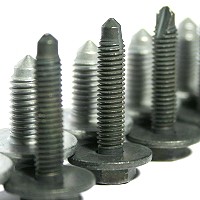Electrolytically applied zinc and zinc alloy coatings (zinc-iron, zinc-nickel) through electrochemical deposition on the object that is to be coated. With the electroplating process, current is produced in an electrolytic bath.
Located at the positive pole (anode) is the metal (e.g., zinc, iron or nickel) that is to be applied; located at the negative pole (cathode) is the object that is to be plated.
Electroplated zinc
Galvanic, unalloyed zinc coating, Cr-(VI)-free passivated, additional sealant or lubricant treatment.
Chromium-VI-free
Pb-free
Cd-free
RoHS-compliant
Passivations, chromium-(VI)-free
- Blue passivation
- Transparent passivation
- Thin-layer passivation
- Thick-layer passivation
Sealants, including
- TNT 11 / TNT 15
- Delta Coll
- Finigard
- Others on request
Lubricant treatment, including
- Torque n’ Tension Fluid (TTF)
- Gleitmo
- OKS
- Others on request

Electroplated zinc- iron
Zinc alloy coating
Zinc-iron coating, Cr-(VI)-free passivated, additional sealant or lubricant treatment
Chromium-VI-free
Pb-free
Cd-free
RoHS-compliant
Passivations, chromium-(VI)-free
- Passivations, chromium-(VI)-free
- Transparent passivated
- Black passivated
Sealants, including
- Finigard 105
- Delta Coll
- TNT
- Others on request
Lubricant treatment, including
- Torque n’ Tension Fluid (TTF)
- Gleitmo
- OKS
- TNT
- Others on request

Electroplated zinc-nickel
Zinc alloy coating
Zinc-nickel coating, Cr-(VI)-free passivated, additional sealant and lubricant treatment.
Chromium-VI-free
Pb-free
Cd-free
RoHS-compliant
Passivations, chromium-(VI)-free
- Transparent passivated
- Black passivated
Sealants, including
- Finigard 105
- Delta Coll
- Others on request
Lubricant treatment, including
- Torque n’ Tension Fluid (TTF)
- Gleitmo
- OKS
- TNT
- Others on request

Electroplated Zinklad 250
Zinklad 250
Unalloyed zinc coating, colorless Cr-(VI)-free thick-layer passivation and sealant with integrated lubricant.
Chromium-VI-free
Pb-free
Cd-free
RoHS-compliant
Layer thickness
- Recommended: 16 µm
Color
- Silver, glossy

Electroplated Zinklad MGL, MG
Coating for connecting elements for preventing contact corrosion with magnesium.
Zinklad MG
Unalloyed zinc coating, colorless Cr-(VI)-free thick-layer passivation and sealant
Zinklad MGL
Unalloyed zinc coating, colorless Cr-(VI)-free thick-layer passivation and sealant with integrated lubricant
Chromium-VI-free
Pb-free
Cd-free
RoHS-compliant
Layer thickness
- Approx. 20 – 25µm
Color
- Silver, glossy

Zinc phosphating
Zinc phosphating
Together with oiling, phosphating serves as a temporary protection against corrosion
- Thin-layer zinc phosphating
- Thick-layer zinc phosphating
- Oil
- Gardorol CP 8006
- Others on request


